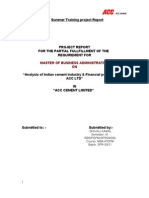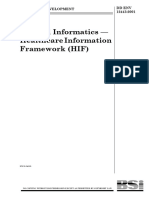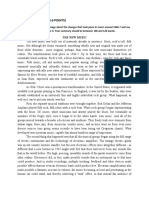0 ratings0% found this document useful (0 votes)
37 viewsSystem Plan and Design: Irrigation
System Plan and Design: Irrigation
Uploaded by
SarahThe document discusses irrigation system planning and design. Proper design requires matching the pumping system to efficiently provide the pressure and flow rate required by the irrigation distribution system. An irrigation plan is needed to lay out the system cost effectively and provide installation details. The plan should include topographic data, water source capacity, soil/crop characteristics, design parameters, and design data like nozzle selection and sprinkler spacing.
Copyright:
© All Rights Reserved
Available Formats
Download as DOCX, PDF, TXT or read online from Scribd
System Plan and Design: Irrigation
System Plan and Design: Irrigation
Uploaded by
Sarah0 ratings0% found this document useful (0 votes)
37 views1 pageThe document discusses irrigation system planning and design. Proper design requires matching the pumping system to efficiently provide the pressure and flow rate required by the irrigation distribution system. An irrigation plan is needed to lay out the system cost effectively and provide installation details. The plan should include topographic data, water source capacity, soil/crop characteristics, design parameters, and design data like nozzle selection and sprinkler spacing.
Original Description:
Hi!!!!!
Original Title
Irrigation
Copyright
© © All Rights Reserved
Available Formats
DOCX, PDF, TXT or read online from Scribd
Share this document
Did you find this document useful?
Is this content inappropriate?
The document discusses irrigation system planning and design. Proper design requires matching the pumping system to efficiently provide the pressure and flow rate required by the irrigation distribution system. An irrigation plan is needed to lay out the system cost effectively and provide installation details. The plan should include topographic data, water source capacity, soil/crop characteristics, design parameters, and design data like nozzle selection and sprinkler spacing.
Copyright:
© All Rights Reserved
Available Formats
Download as DOCX, PDF, TXT or read online from Scribd
Download as docx, pdf, or txt
0 ratings0% found this document useful (0 votes)
37 views1 pageSystem Plan and Design: Irrigation
System Plan and Design: Irrigation
Uploaded by
SarahThe document discusses irrigation system planning and design. Proper design requires matching the pumping system to efficiently provide the pressure and flow rate required by the irrigation distribution system. An irrigation plan is needed to lay out the system cost effectively and provide installation details. The plan should include topographic data, water source capacity, soil/crop characteristics, design parameters, and design data like nozzle selection and sprinkler spacing.
Copyright:
© All Rights Reserved
Available Formats
Download as DOCX, PDF, TXT or read online from Scribd
Download as docx, pdf, or txt
You are on page 1of 1
TLE
Irrigation System Plan and Design
Water required by crops is supplied by nature in the form of precipitation, but when it
becomes scarce or its distribution does not coincide with demand peaks, it is then necessary to
supply it artificially, by irrigation. Several irrigation methods are available, and the selection of
one depends on factors such as water availability, crop, soil characteristics, land topography, and
associated cost.
Proper design of an irrigation system requires that the pumping system precisely match
the irrigation distribution system so that the pressure and flow rate required can be efficiently
provided by the pumping system. The energy required to pump water is determined by the total
dynamic head (water lift, pipe friction, system pressure, etc.), the water flow rate desired,and the
pumping system's efficiency.
Irrigation water management involves determining when to irrigate, the amount of water
to supply each irrigation event and during each stage of plant, and operating and maintaining the
irrigation system. The main management objective is to manage the production system for profit
without compromising environment and in agreement with water availability. A major
management activity involves irrigation scheduling or determining when and how much water to
apply, considering the irrigation method and other field characteristics.
FUNCTIONS OF FARM IRRIGATION SYSTEMS
The primary function of farm irrigation systems is to supply crops with irrigation water in
the quantities and at the time it is needed. Specific functions includes:
1. Diverting water from the water source.
2. Conveying it to individual fields within the farm.
3. Distributing it within each field.
4. Providing a means for measuring and regulating flows.
Other functions of farm irrigation system include crop and soil cooling, protecting crops
from frost damage, delaying fruit and bud development, and controlling wind erosion, providing
water for seed germination, application of chemicals, and land application of wastes.
REASONS FOR AN IRRIGATION PLAN
• A project plan enables the designer to lay out the irrigation system in the most cost
effective way. The plan is used to generate a material list and to evaluate the anticipated
project costs.
• The plan provides step by step information on system installation. Information on crop
spacing, sprinklers, pumping requirements, pipeline sizes and lengths should be included
in the plan. Pertinent obstructions such as roads, trees, gas, oil, water, telephone, or
transmission lines must also be indicated.
• Specification, design standards, and work schedules as set out in a plan on the basis of
any contractual agreements between the installation contractor and the farmer.
• The plan provides a record for future reference. It can be used for overall farm planning
and identifies limits of expansion potential.
ESSENTIAL FEATURES OF A PLAN
• Topographic Data - The field shape must be accurately drawn showing pertinent
obstructions, features and elevation details.
• Water Source Capacity - The water supply must be clearly indicated showing location
and available capacity.
• Depending on the water source, a well log or water license must accompany the
irrigation plan. Irrigation reservoirs also require Water Management Branch licensing.
• Soil and Crop Characteristics - Soil and crop limitations must be accounted for to
reduce runoff and deep percolation by mismanagement of the irrigation system.
• Design Parameters - Soil water holding capacity, maximum application rate and climatic
data must be used to select the correct irrigation system design.
• Design Data - The nozzle selected, operating pressure, discharge rate and sprinkler
spacing must all be shown on the plan. The irrigation interval, set time, application rate
and net amount applied must also be calculated.
You might also like
- WP Creating Maintaining Soc PDFDocument16 pagesWP Creating Maintaining Soc PDFgeo36No ratings yet
- Employees Satisfaction and Quality of Work Life at Tata SteelDocument84 pagesEmployees Satisfaction and Quality of Work Life at Tata SteelSwati Sharma100% (5)
- Project Report in FinanceDocument53 pagesProject Report in Financeshivali_kamal462275% (36)
- Free Eth ScriptDocument5 pagesFree Eth Scriptk0lanNo ratings yet
- Tle 7 11 15Document18 pagesTle 7 11 15Den SeguenzaNo ratings yet
- Hort. Week 6Document12 pagesHort. Week 6graceangelmartinez2No ratings yet
- Tec 165 Lesson 3Document30 pagesTec 165 Lesson 3Mary Grace CarpioNo ratings yet
- Lecture7 Irrigation Engineeing IIDocument24 pagesLecture7 Irrigation Engineeing IIOmar IsaackNo ratings yet
- Chapter 3 Pressurized Irrigation2 ZigyibelDocument28 pagesChapter 3 Pressurized Irrigation2 ZigyibelSolomon AdelaNo ratings yet
- CHAPTER4 Methods of Applying Irrigation WaterDocument71 pagesCHAPTER4 Methods of Applying Irrigation Waterceejaypaloma28No ratings yet
- Surface Irrigation Design Chapter 5Document60 pagesSurface Irrigation Design Chapter 5Kelvin ChinyerereNo ratings yet
- Chapter 3-Surface Irrigation DesignDocument68 pagesChapter 3-Surface Irrigation DesignEng Ahmed abdilahi IsmailNo ratings yet
- FAO Paper 45Document30 pagesFAO Paper 45Aboalmaail AlaminNo ratings yet
- CH-5 Water Allocation and Delivery ScheduleDocument27 pagesCH-5 Water Allocation and Delivery SchedulemitkiedegaregeNo ratings yet
- Answer For Assignment #2Document11 pagesAnswer For Assignment #2Chanako DaneNo ratings yet
- Answer For Assignment #2Document10 pagesAnswer For Assignment #2Duge GaltsaNo ratings yet
- POP Up SYSTEM PROPOSALDocument14 pagesPOP Up SYSTEM PROPOSALFrancis KairaNo ratings yet
- NAbard Model Bank ProjectsDocument44 pagesNAbard Model Bank ProjectsSrinivasan SakthivelNo ratings yet
- Hydrology, Irrigation and Flood Management L4/T1 (Civil Engineering Department)Document21 pagesHydrology, Irrigation and Flood Management L4/T1 (Civil Engineering Department)Mirza Md. Nazmus SakibNo ratings yet
- Precision FarmingDocument43 pagesPrecision FarmingParthasarathi100% (1)
- MERCADO Assignment in AfaDocument2 pagesMERCADO Assignment in Afareychen1330No ratings yet
- Irjet V9i6485Document5 pagesIrjet V9i6485kzakari.1231No ratings yet
- Module 3 - Principles of Irrigation and Draiange EngineeringDocument46 pagesModule 3 - Principles of Irrigation and Draiange EngineeringAnonymous Mtomzixac100% (2)
- Assignment No. 2 Dr. MohsinDocument8 pagesAssignment No. 2 Dr. Mohsindanishbiggest124No ratings yet
- Scheme Operation, Maintenance and Management Ver-6Document82 pagesScheme Operation, Maintenance and Management Ver-6Kefale DessalewNo ratings yet
- Analysis of Canal Irrigation SystemDocument7 pagesAnalysis of Canal Irrigation SystemDeepjyoti PurkayasthaNo ratings yet
- Crop Water ManegmentDocument10 pagesCrop Water ManegmentayeshaNo ratings yet
- Bhavliya Pressure IrrigationDocument40 pagesBhavliya Pressure Irrigationkaran ahari100% (1)
- IrrigationDocument12 pagesIrrigationfarazimarzan78No ratings yet
- IRRIGATION SYSTEMS DESIGN NOTES - MR Mpala LSUDocument163 pagesIRRIGATION SYSTEMS DESIGN NOTES - MR Mpala LSUPanashe GoraNo ratings yet
- Irrigation TechnologiesDocument77 pagesIrrigation TechnologiesJonathan SikanyikaNo ratings yet
- November 15 2019 SWM Planning and Lot Level Design and ControlDocument86 pagesNovember 15 2019 SWM Planning and Lot Level Design and ControlMJKHTNo ratings yet
- Assignment II Roots&Tubers PC Yam GroupDocument6 pagesAssignment II Roots&Tubers PC Yam GroupmouleroelhackimNo ratings yet
- Sprinkler IrrigationDocument16 pagesSprinkler IrrigationAnusha NomulaNo ratings yet
- CED - Potable Water PlumbingDocument41 pagesCED - Potable Water PlumbingJeganath KabilNo ratings yet
- Criteria For Scheduling IrrigationDocument19 pagesCriteria For Scheduling IrrigationDrMohni ParmarNo ratings yet
- Design of Potable Water Plumbing Systems: Course No: M04-023 Credit: 4 PDHDocument41 pagesDesign of Potable Water Plumbing Systems: Course No: M04-023 Credit: 4 PDHRoyce Tang KwangNo ratings yet
- Interpret Farm Plans and DrawingDocument26 pagesInterpret Farm Plans and Drawingmarvin panguitoNo ratings yet
- Design of Potable Water Plumbing SystemsDocument41 pagesDesign of Potable Water Plumbing SystemsAhmed AL-ChadrchiNo ratings yet
- Ajwad AssignmentDocument10 pagesAjwad Assignmentalinsonu21212No ratings yet
- Sustainable Irrigation v2Document2 pagesSustainable Irrigation v2suedasNo ratings yet
- 03 - RS-GIS in IrrigationDocument19 pages03 - RS-GIS in IrrigationMohamoud AbdulahiNo ratings yet
- WatershedDocument15 pagesWatershedterefa1234No ratings yet
- Applications of Gis and Remote Sensing in The Field of "Irrigation and Agriculture"Document19 pagesApplications of Gis and Remote Sensing in The Field of "Irrigation and Agriculture"Dileesha WeliwaththaNo ratings yet
- Participatory Irrigation Management: Rajat Mishra Asst. Professor Civil Engineering DepartmentDocument37 pagesParticipatory Irrigation Management: Rajat Mishra Asst. Professor Civil Engineering DepartmentDileesha WeliwaththaNo ratings yet
- 1.1general: 1. Water That Is Evaporated From The Facility, For Example From The Cooling TowersDocument2 pages1.1general: 1. Water That Is Evaporated From The Facility, For Example From The Cooling TowerskalpanamandavaNo ratings yet
- Presentation O&MDocument53 pagesPresentation O&Mvinayasm0% (1)
- Introduction To Irrigation DesignDocument40 pagesIntroduction To Irrigation DesignEifa Mat LazimNo ratings yet
- BUST Irrigation NotesDocument96 pagesBUST Irrigation NotesChu maiNo ratings yet
- Public Building Water Auditing Best PracticesDocument6 pagesPublic Building Water Auditing Best PracticesRichli HarleyNo ratings yet
- Irrigation Engineering: (3.0 Chrs 2.0 Th+1.0 Lab)Document65 pagesIrrigation Engineering: (3.0 Chrs 2.0 Th+1.0 Lab)Ahmed SulemanNo ratings yet
- GIS Applications in AgricultureDocument6 pagesGIS Applications in AgricultureAsqa KhanNo ratings yet
- Drip Irrigation DesignDocument44 pagesDrip Irrigation DesignSimranjeet Chawla75% (4)
- Dug Wells 1.0. GENERALDocument9 pagesDug Wells 1.0. GENERALVinayak KoliNo ratings yet
- ModelDocument14 pagesModelmanas dadharaNo ratings yet
- Introduction To Furrow IrrigationDocument10 pagesIntroduction To Furrow Irrigationrujinakhatun2006No ratings yet
- Design of A Fuzzy Logic Controller Applied To A GSM - Based Bucket Drip Irrigation SystemDocument2 pagesDesign of A Fuzzy Logic Controller Applied To A GSM - Based Bucket Drip Irrigation Systemvhito619No ratings yet
- AGE23 Lesson 3 LContentDocument12 pagesAGE23 Lesson 3 LContentalwaysremembering14No ratings yet
- Systematic Methods of Water Quality Parameters Analysis: Analytical MethodsFrom EverandSystematic Methods of Water Quality Parameters Analysis: Analytical MethodsNo ratings yet
- Drip Irrigation : Efficient Water Delivery for Crop GrowthFrom EverandDrip Irrigation : Efficient Water Delivery for Crop GrowthNo ratings yet
- COVID-19 Testing Report FinalDocument25 pagesCOVID-19 Testing Report FinalNick ReismanNo ratings yet
- Why Are Filipinos Good at Singing (DISS PeTa)Document6 pagesWhy Are Filipinos Good at Singing (DISS PeTa)kayeNo ratings yet
- Module 5: Data Management: RequiredDocument7 pagesModule 5: Data Management: RequiredasimNo ratings yet
- Payment of Bonus Act FormsDocument5 pagesPayment of Bonus Act Formspratik06No ratings yet
- Sample of Notarial WillDocument1 pageSample of Notarial WillRover DiompocNo ratings yet
- Price List Lomos For Sales (13 Jan, 2023) MDocument338 pagesPrice List Lomos For Sales (13 Jan, 2023) MFris AinurNo ratings yet
- Ducati Monster 696 - Eu - 2009Document142 pagesDucati Monster 696 - Eu - 2009uauxjoNo ratings yet
- I Would Fight Back,: (Yo Lucharía Si Fuera Tú.) (En Realidad Yo No Soy Tú.)Document3 pagesI Would Fight Back,: (Yo Lucharía Si Fuera Tú.) (En Realidad Yo No Soy Tú.)Diana Carolina Limaco CandiaNo ratings yet
- DD Env 12443-2001Document34 pagesDD Env 12443-2001jamNo ratings yet
- AJULUCHUKU v. NNAKWE - Document No. 4Document4 pagesAJULUCHUKU v. NNAKWE - Document No. 4Justia.comNo ratings yet
- Judicial Applications of Artificial IntelligenceDocument36 pagesJudicial Applications of Artificial IntelligencenovisadNo ratings yet
- Educational Unit Adolfo María Astudillo: Table 1Document4 pagesEducational Unit Adolfo María Astudillo: Table 1Maria Jose Hurtado MoraNo ratings yet
- Law For The Entrepreneur and ManagersDocument44 pagesLaw For The Entrepreneur and ManagersEbun EgbewunmiNo ratings yet
- MichelangeloDocument11 pagesMichelangeloFlorinAnghelNo ratings yet
- Teaching and Learning Foreign Languages in Uzbekistan. CEFR: Learning, Teaching and AssessmentDocument5 pagesTeaching and Learning Foreign Languages in Uzbekistan. CEFR: Learning, Teaching and AssessmentresearchparksNo ratings yet
- The Use of Recycle Material in ManufacturingDocument26 pagesThe Use of Recycle Material in ManufacturingKasidis NaktupNo ratings yet
- Respond To Emergencies: Hipboard Contingency PlanDocument3 pagesRespond To Emergencies: Hipboard Contingency Planmithilesh seloteNo ratings yet
- Wa0037.Document1 pageWa0037.amosambitious84No ratings yet
- Student DiversityDocument49 pagesStudent DiversityBhaskar TupteNo ratings yet
- The Philippine Extradition LawDocument5 pagesThe Philippine Extradition LawJani LucasNo ratings yet
- CS Sample PaperDocument3 pagesCS Sample PaperAbhishekNo ratings yet
- CFCPR 3 PDFDocument168 pagesCFCPR 3 PDFece142No ratings yet
- Verse Ibrahim From Holy QURANDocument7 pagesVerse Ibrahim From Holy QURANMohammed Abdul Hafeez, B.Com., Hyderabad, IndiaNo ratings yet
- A Study On Meriiboy Ice Cream Company With Special Reference To Human Resource DepartmentDocument46 pagesA Study On Meriiboy Ice Cream Company With Special Reference To Human Resource DepartmentSruthy psNo ratings yet
- Section D. Writing (6.0 Points) : The New MusicDocument3 pagesSection D. Writing (6.0 Points) : The New MusicNgân LêNo ratings yet
- PD 532 ANTI PIRACY AND HIGHWAY ROBBERYodtDocument2 pagesPD 532 ANTI PIRACY AND HIGHWAY ROBBERYodtDawn JessaNo ratings yet

























































































